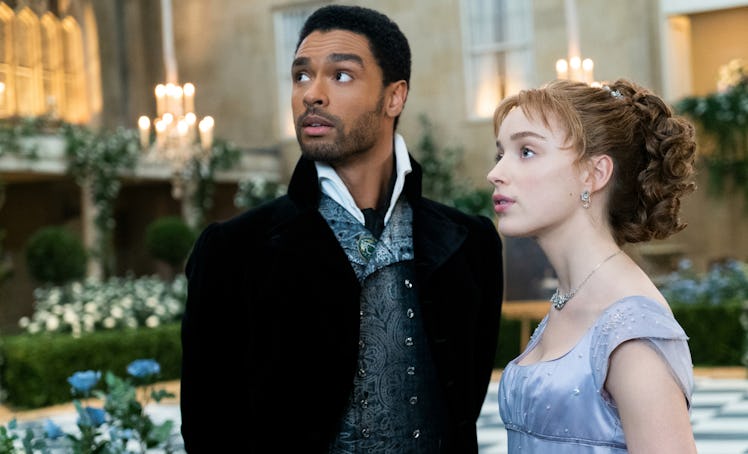
9 Historical Inaccuracies In 'Bridgerton' Season 1 You Won't Be Able To Unsee
It's no secret Bridgerton is more of a romantic fantasy than an actual chronicle of the Regency era, and some fans have begun pointing out all the inaccuracies that pop up in the series. From rogue department store posters to costuming details, there are quite a few little blunders that definitely don't belong in 1813. If you want to spot all the anachronisms, these historical inaccuracies in Bridgerton Season 1 will have you re-examining all the tiny details in the show on your next rewatch.
Based on Julia Quinn's series of romance novels, Bridgerton takes place in an imagined version of 19th-century London. Of course, many of the details about British high society in 1813 are actually based in historical fact. For instance, the ton (a term used for high society at the time) did engage in a social season in a similar fashion to the one in the series. Even the show's casting of a Black woman (Golda Rosheuvel) as Queen Charlotte has a historical backing, as scholars believed the actual Queen Charlotte may have been Black.
However, the series wasn't able to keep every modern-day invention from showing up on screen, whether it was intentional or not. Here are some of the most glaring errors:
1. The Yellow Parking Line
Some fans noticed a yellow parking line visible in certain scenes of the show. These traffic lines weren't introduced until the 1950s, so they definitely would not have been around in the Regency era.
2. Manhole Covers
Viewers also spotted some modern manhole covers on the streets, which would not have been around until much later in the 19th century.
3. Seedless Grapes
Even something as tiny as a grape can take certain eagle-eyed viewers out of the fantasy of Bridgerton. Fans spotted some seedless grapes, a variety of the fruit that did not exist until the end of the 19th century, in the show.
4. The Primark Poster
Pretty much everyone in the UK is familiar with the fast-fashion store Primark, but the Bridgertons definitely would not have shopped there. However, one fan pointed out a Primark poster in the background of one of Simon Basset's (Regé-Jean Page) scenes. The department store was founded in 1969, over a century and a half after the time of Bridgerton.
5. Doorbell
Some fans also claim a modern doorbell is visible in certain scenes. Although the first electric doorbell was invented in 1831, they didn't become commonplace until the early 1900s.
6. Glitter
While many of these anachronisms may have been unintentional, the show's costume designers were fine breaking out of the early 1800s to really make all the gowns sparkle. Even though glitter wasn't first manufactured and distributed until 1934, the sparkly stuff is featured heavily in the costumes.
Bridgerton costume designer Ellen Mirojnick admitted in a Harpar's Bazaar interview that the team intentionally stepped outside of the time period to really make the looks pop for modern viewers: "We have increased the amount of glitter, increased the amount of color, increased the over embellishing. We have done things that actually can relate a little bit more to today's point of view."
7. Corsets
Hardcore fans of historical garments were quick to point out that Bridgerton is particularly inaccurate when it came to corsetry. In 1813, high-society women wore short stays rather than corsets, and would not have tied it onto bare skin. Corsets didn't become in fashion again until the Victorian era, a couple decades after the time period of Bridgerton.
8. Daphne's White Wedding Dress
There's no denying Daphne Bridgerton (Phoebe Dynevor) looked stunning on her wedding day, but if Bridgerton were to be historically accurate, she would not have worn white. Wearing a white wedding gown didn't become the norm until Queen Victoria debuted a white dress at her wedding in 1840. Before then, high-society brides wore rich colors with fur and gold embroidery, which made for extravagant wedding dresses.
9. The Wedding Cake
Daphne and Simon's wedding cake was also notably out of place in 1813. While cakes have long been used in wedding celebrations, the couple's decadent four-tier confection would have actually been much more humble in 1813. It wasn't until the 1882 wedding of Prince Leopold, the Duke of Albany, that the modern, tiered wedding cake that is common today was first introduced.
OK, so some of these anachronisms are clearly intentional to add to the stunning visuals, while others are tiny blunders. But you know what? They all make for a fun game for history buffs watching Bridgerton.
This article was originally published on